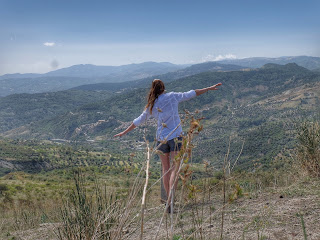This southern Italian region is probably one of the most underestimated ones. Besides TROPEA and LE CASTELLA that are famous even on the other side of the Atlantic Ocean, the rest of this wild region is almost untouched by the tourists. But just recently I've red an article on a noted Italian newspaper revealing the richness and diversity of this region. I'm just glad I got to see it as it is right now, before the building speculation is gonna ruin it (the process already started) and before it becomes a luna park for tourists, as it is today most of Apulia.
In fact Tropea on the Tyrrhenian sea has splendid panorama corners and crystal clear water, long history too. But it is unbearable roaming among so many people, the noise, the disorder, overall chaos and insane prices are disturbing.
 |
| Tropea |
 |
| View on Sicily from Tropea at sunset |
Scilla is on it's way to become the same. From these two borgo's you can see Sicily and the volcano Stromboli on clear days, discover history while roaming around, get lost in the small streets, definitely buy plenty of souvenirs and have a pricy lunch/dinner with breathtaking panorama.
 |
| Scilla |
But if you go to Capo Vaticano, there are plenty of fascinating beaches that you can reach only by climbing and trekking (but the walk is definitely worth it! Just take some water and food with you because you'll find only nature there. Don't forget to take your trash back with you!).
 |
| Capo Vaticano |
Pizzo is another little borgo on the Tyrrhenian that is famous for the ice-cream TARTUFO ( Gelato tartufo), you have to try the original! For those who studied Italian history, Gioacchino Murat - king of Naples, was held captive and died in the Castle of Pizzo.
Vibo Valentia is a borgo close by on the hill where you can visit a splendid Castle that follows the usual ownership path as most of the south Italian castles: ROMAN fortification >>> BYZANTINE fortress >>> NORMAN/SWABIAN castle >>> ANGEVIN palace >>> ARAGONESE mansion >>> BORBONESE prison. Keep this in mind as all the upcoming castles I am gonna talk about had the same, about 2000 years long, transformation journey.
 |
| Vibo Valentia |
Reggio Calabria is the biggest town in the region and it has the most fascinating Archeological Museum (where I spent 5h!!!) and where famous BRONZI DI RIACE are exposed (bronze nude statues of Greek warriors from 450BC that were found under sea in 1972 close to Riace, testimony of Magna Grecia's heritage). Reggio has a long and tortuous history as it was situated in the middle of the most important sea trading roads. But that was it's strength and weakness too, because it got sacked many times, favorite pray to the pirates. From Reggio you can closely see Sicily or even go for a tour by boat.. I would advice you to keep it as a very last destination, so everything you've learned on the way is gonna be confirmed by the museums rich explanations and tour. Or as the very beginning of your journey, so that you can first learn what you're about to see and then actually go and see it (might be the most comfortable option as Reggio is connected by sea, land and especially air, while the rest of the region - not really).
 |
| Reggio Calabria |
But I am here to talk about those hidden jewels on the IONIAN COAST that nobody talks about and only a few visit. I've only met some German and Dutch here and there. Be ready for a lot of driving, narrow streets with holes and gravel. no illumination, hairpin bends on the top of the mountains, abandoned villages and mesmerizing panoramas!
Going south from Reggio and turning towards the mountains after Saline Ioniche, the first adventure starts immediately, destination Pentidattilo, the abandoned village. Now this is just the first and probably the most touristic one from many in this area. This borgo takes its name from the rock form that looks like 5 fingers and the village is built among the rock, it's one all together. Pentidattilo has a tremendous history linked to the massacre of enemy families Alberti and Montebello, in fact it is believed to be a ghost town. But there are still some brave artisans trying to keep it alive by selling souvenirs and typical art works. Nobody lives there though, the new village is 1km away.
 |
| Pentidattilo |
For the next one you might want to spare the whole day because it is extremely difficult to reach, clearly in the lands of Aspromonte National Park. But the view is breathtaking and the history uniquely fascinating. Roghudi Vecchio is a completely abandoned village (I'd say a real ghost village) that lost its population in 1973 due to the heavy floods and landslides. Fun fact is that you can find fixed nails next to the houses that were used to bind the children to the ankle. No, it is not some horror outback movie, but simply to prevent them from falling down the ravine while playing. It is a bit creepy though. To dissuade you even more from this venture, you might see some abandoned cars in the ravine on the way, probably fell and exploded, who knows! But I met a very generous "new age" shepherd (as in they're not using donkeys to move around anymore, but the indestructible Panda 4x4) who was looking after his goats and gave us precious advices on the way.
You might wanna stop in Bova before or after visiting Roghudi (inevitably on the way), it has been awarded with "orange flag" as one of the most beautiful Italian borgo's.
Close by on the coast in Palizzi Marina is the most southern point of Italy, the tip of the boot, with the view on open sea, Ionian becoming Mediterranean. Imagine how many Saracen pirates, Crusaders, Knights of Saint John and royal fleets has this spot seen!
 |
| Tip of the boot, most southern point of Italian peninsula |
Another semi-abandoned village is Staiti. I literally met only 4 people. It is very scenic and here is where i found plenty of doors with the paintings and famous quotes such as "who desires to see the rainbow, has to learn to love the rain" by Paolo Coelho. Just before the village on the hill, if you take a narrow road on the left, you'll reach the splendid Abbey dated from the Byzantines with originally Greek orthodox cult.
 |
| Staiti |
At this point you're heading north, all on the Ionian Coast. A must see borgo is Gerace, full of mysterious history, beauty and panorama. The most imposing cathedral of Calabria is on this hill where the ancient population of Locri escaped from the coast, haunted by the Saracen pirates. Gerace used to have around 100 churches, but today "only" 17 are left (for the population of 2600 people on 35km!). Gerace's castle was built by the Byzantines on a naturally isolated rock and the only connection to the village was by a drawbridge. The castle was almost impregnable, in fact it was the main shelter for the population during the Saracen raids on the coast. Arabs finally managed to take it only after repetitive attacks and held it just for some decades, until the Norman liberation.
 |
| Gerace |
Stilo is another interesting borgo, this time very much alive, although reconstruction is needed in many corners, starting from the cathedral which is closed and unused!!! There are plenty of hermit caves around Stilo, but the absolute protagonist is Cattolica, a Byzantine orthodox church from the 9th century built of brick with vivid frescoes in the interior. In AD 1577 the church was converted to the latin rite, but some inscriptions in Arabic led the scholars to suspect it might have been historically used as a Muslim oratory too.
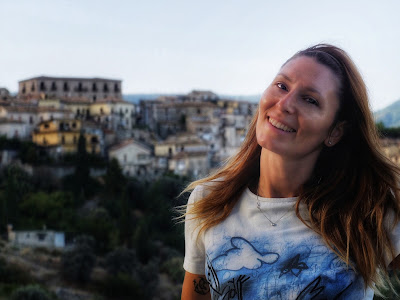 |
| Stilo |
Going deeper to the mountains of Serra (just in between the two coasts, Tyrrhenian and Ionian), there is a little jewel of mountain town that will make you believe you are on the Alps or Dolomites. Serra San Bruno is such a parallel reality, you will completely forget you are in the south of Italy! The place is famous for its Charterhouse, home to the Carthusian order who's very founder was San Bruno in Grenoble, French Alps. Bruno received some land in Italy from Ruggero the Norman around AD 1080, so he founded the second Charterhouse right here in Serra San Bruno. This religious order still exists today and they produce a special Elixir made of 50 herbs which is very healthy. The receipt is still a secret and only two brothers at a time know half of it, then it gets passed on to the following oldest brother and so on.
 |
| Serra San Bruno |
Back towards the coast there is another semi-abandoned town of Badolato. It must be very strange and a bit creepy living in a town where around you there are only abandoned houses and at the end of the steep street there might be another inhabited house. Tourists come to visit, artists come to create and get some peace. You have to climb town to get to the church, but the view on the sea coast is amazing.
Next seaside town is Soverato, quite famous and immediately you can see constructions. I worked there in 2007 as an entertainer in a touristic village, ha! The pay was shitty, the work was extreme, but it was worth it if you like performing on a stage and all the camaraderie that comes along!
Before getting to Squillace borgo, on the seaside you will find le vasche di Cassiodoro, natural formation of the rocks forming basins that were used for fishing. The area is already far too much touristic, in fact there are many abusive constructions up to this hostorical point. Much more fascinating is the borgo of Squillace up the hill where you can visit the Castel under the sound of medieval music. Borgia family (yes, the ones from Florence!) got this Byzantine-Norman Castle by marriage. In fact nearby there is a small village named by the very Prince who saved the population from pestilence by moving them to a new settlement that he named by his family name: Borgia.
 |
| Squillace |
Next stop is Tiriolo, a legendary uphill village in between the two coasts of only 25km wide piece of land (narrowest point of Italian peninsula), where both seas are visible: Ionian and Tyrrhenian. Actually if the weather is good, from here you can even see Sicily and Stromboli vulcano. It is extremely fascinating and worth visiting at sunrise or sunset time. I had an unforgettable urban SAFARI on APE Piaggio, up till the top of the mountain.
 |
| Tiriolo |
Cannot skip Catanzaro, capital of the region and the 2nd most populated town in Calabria. You'll be once again astonished how the cathedral is locked and out of use and the historical theater falling apart. Around AD 903 the Byzantine town Katantzarion got sized by the Saracens who founded an emirate and took the Arab name of قطنصار QaTanSaar. Between the 9th and 11th century Catanzaro was the first center to introduce SILK production to Italy and became the main supplier in almost all of Europe.
 |
| Catanzaro |
On the Ionian coast only Le Castella is popular and touristic, famous setting for the film BRANCALEONE in the splendid aragonese Castle which is still standing.
 |
| Le Castella |
Back on the mountain there is a fantastic town of Santa Severina with a majestic Castle hosting events, concerts and exhibitions and a mesmerizing view on Sila mountain range. This little borgo is full of life and the farmhouse I was staying at, just outside the old town is a definition of peace, quality homemade food, beauty in the middle of centuries old olive trees.
Back to the coast ancient town of Capo Colonna is today an archeological site. Home to Hera, the most powerful Greek goddess of fertility, maternity and generosity. In the 6th century BC the greatest temple of Magna Grecia happened to be right here and Hera was the protector of the sailors. Even Hannibal worshipped her in this very temple. Only one Doric column is still standing.
 |
| Capo Colonna |
Glorious Crotone was a complete disappointment. SIC TRANSIT GLORIA MUNDI. Not because the town is so dirty, old important buildings falling apart. But because the historical glory was so great, being one of the most important centers of Magna Grecia, that the modern destruction is just unacceptable. Seaside speculation in constructions on the other hand stands tall. Perfect example of modern versus ancient.
 |
| Crotone |
Rossano holds a unique CODEX PURPUREI, a Greek illuminated gospel dating to the 6th century made in a Byzantine scriptorium for the Eastern Roman emperor. It is now UNESCO heritage as a precious manuscript containing "memory of the world". There is only a number of those around the world. Also I've had the best homemade almond milk ever!
 |
| Rossano |
 |
| Codex Purpurei |
A two faced borgo is definitely Corigliano Calabro: on one side of the hill there is the old town with typical historical buildings and the Duke's Castle dominating not only the borgo, but the whole Sibaritide valley. On the other side of the hill new town all under construction and total speculation of modernity. Beauty and the Beast.
 |
| Corigliano Calabro |
Getting deeper into the Sibaritide valley, visiting Sibari's archeological rests and museum is a must. Founded around 700 BC by the Greek settlers, Sibari had 200 years of luxurious prosperity which arose so much envy that around 500 BC it got destroyed by the brother city Croton (speaking the same language, worshiping the same God's, rings a bell?). Reconstructed by the Athenese with a new name THURII and then under Romans as COPIA, the town got finally abandoned around AD 400 after an earthquake.
Further north, deep into the mount rage of Pollino there is Morano Calabro, a cute little borgo on the top of the hill. Of course I visited the Castle and learned some more. But the farmhouse I was staying in, just outside the old town, was a magical fairy tale place in the middle of nature, fresh air and excellent food.
 |
| Morano Calabro |
If you love those best seller medieval history books with knights and kings, visiting the Castle of Roseto Capo Spulico will make your head spin in a long enchanting moment of time traveling. This Federico II's castle is overhanging on the Ionian sea and since it was sold to a private, it is now a restaurant and lounge bar, maintaining medieval furniture and setting. You'll feel like a Castellana, so dress up for it! Or enjoy swimming in a crystalline sea just at the foot fo the castle, like I did.
Oriolo is a small village in the valley, surrounded by mountains. It has a great castle and cute borgo. The panorama around the valley just to get there is already worth the trip.
And FINALLY the last (or the first) borgo that you will encounter on the north-eastern border of Calabria region is Rocca Imperiale, little borgo on the top of the hill with a shape of a cake and the cherry on the top is the Castle (you learned that by now, right? Every significant borgo has a Castle and a Cathedral. The rest is optional). It is a spiral of narrow cute streets as much labyrinthine as inviting. Eventually you'll get on the top and enjoy a majestic view. If you wonder why all the houses have bottles of water in front of the doors, it's because of the cats.
And with this enchanting place I conclude my coast to coast journey in Calabria. Keep in mind a few more information:
1- most of the museums, castles and institutions are open in the morning until 12/13h and then from 16h. So there is a lunch break!
2- there is no transporting connection to all the mention places, so your only option is to rent a car. Drive carefully because the streets are not always clean.
3- do not touch FICHI D'INDIA (prickly pears), they are everywhere. English name suggest that they are pricking, but Italian one doesn't. Furthermore in Italian it is called "fig", not a pear. The prick is quite bothersome because extremely tiny, therefor difficult to expel.
4- last but not the least, enjoy the wilderness of this region, it means it is still genuine and natural!
 |
| Prickly pears - fichi d'india |


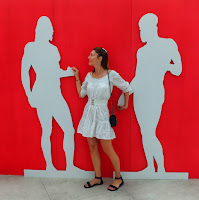


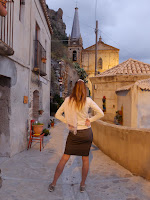










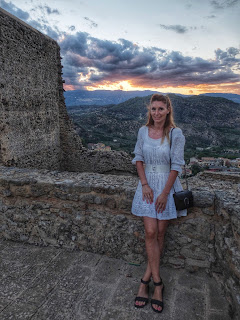


.jpg)

